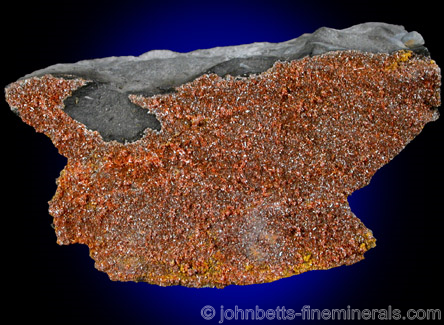The Mineral greenockite

Greenockite is a rare mineral formed mostly of the
element cadmium, and it is the only cadmium mineral of importance. Its occurrence is almost always in association with
Sphalerite, due to a similar
paragenesis, and it often forms as thin coatings on other minerals, especially
Smithsonite and
Calcite. Greenockite forms in unique crystals that are
asymmetrical, with the
basal crystal faces forming at wider angles than the top faces.
Greenockite was named in honor of Earl Charles Murray Cathcart, also known as Lord Greenock, a British army general who subsequently became the Governor General of the Province of Canada. Lord Greenock announced the discovery of Greenockite as a new mineral from the excavation of the Bishopton tunnel, near Port Glasgow in Scotland.
Color
Yellow, orange, brown, red
Properties
Streak
Yellow |
Hardness
3 - 3.5 |
Transparency
Translucent to opaque |
Specific Gravity
4.9 - 5.0 |
Luster
Adamantine to resinous |
Cleavage
1,1;3,2 |
Fracture
Uneven |
Tenacity
Brittle |
Other ID Marks
May fluoresce yellow. |
Uses
Greenockite is the only ore mineral of the element cadmium. Due to the rarity of Greenockite, most cadmium is actually produced as a by-product of lead and zinc ores, especially Sphalerite. Greenockite was once used as a yellow pigment and known as cadmium ochre. Elemental cadmium has many uses, including electronics and batteries (nickel-cadmium), electroplating, and forming of high temperature alloys.
Greenockite is considered a rare collector's mineral, and is much sought after by mineral collectors when in crystallized specimens.
Noteworthy Localities
Some of the best Greenockite crystals, often on
matrix, have come from the Andesite quarry in Kreimbach-Kaulbach, Rhineland-Palatinate, Germany.
Drusy brownish crystals have come from the Kateřina Coal Mine, Radvanice, near Trutnov (Trautenau), Bohemia, Czech Republic; and yellow encrustations from the Paglio Pignolino Mine, Dossena, Bergamo Province, Italy. Small crystals of excellent form were found at the
type locality of the Bishopton Tunnel, Strathclyde, Scotland. In Boliva, microcrystal crustings with a bright red color are found in Llallagua, Potosí Department.
In the U.S., yellow Greenockite coatings and crusts are well known from Joplin, Jasper Co., Missouri and the surrounding area in the Tri-State District. Greenockite microcrystals over Smithsonite have been found at Rush, Marion Co., Arkansas; and bright yellow coatings once occurred at Friedensville, Upper Saucon Township, Lehigh Co., Pennsylvania. Perhaps the best U.S. locality in the U.S. for visible crystals is the Summit Quarry, near Springfield, Union Co., New Jersey, where small crystals were found in a limited find in the 1960's. Yellow Greenockite crusts were found in a one-time construction project at the Route 25 Road cut, Trumbull, Fairfield County, Connecticut.
Distingushing Similar Minerals
Sphalerite and Wurtzite - Different crystal form.